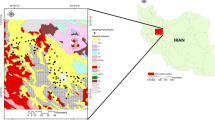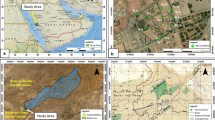Abstract
Groundwater and water resources management plays a key role in conserving the sustainable conditions in arid and semi-arid regions. Applying management tools which can reveal the critical and hot conditions seems necessary due to some limitations such as labor and funding. In this study, spatial and temporal analysis of monthly groundwater level fluctuations of 39 piezometric wells monitored during 12 years was carried out. Geostatistics which has been introduced as a management and decision tool by many researchers has been applied to reveal the spatial and temporal structure of groundwater level fluctuation. Results showed that a strong spatial and temporal structure existed for groundwater level fluctuations due to very low nugget effects. Spatial analysis showed a strong structure of groundwater level drop across the study area and temporal analysis showed that groundwater level fluctuations have temporal structure. On average, the range of variograms for spatial and temporal analysis was about 9.7 km and 7.2 months, respectively. Ordinary and universal kriging methods with cross-validation were applied to assess the accuracy of the chosen variograms in estimation of the groundwater level drop and groundwater level fluctuations for spatial and temporal scales, respectively. Results of ordinary and universal krigings revealed that groundwater level drop and groundwater level fluctuations were underestimated by 3% and 6% for spatial and temporal analysis, respectively, which are very low and acceptable errors and support the unbiasedness hypothesis of kriging. Although, our results demonstrated that spatial structure was a little bit stronger than temporal structure, however, estimation of groundwater level drop and groundwater level fluctuations could be performed with low uncertainty in both space and time scales. Moreover, the results showed that kriging is a beneficial and capable tool for detecting those critical regions where need more attentions for sustainable use of groundwater. Regions in which were detected as critical areas need to be much more managed for using the current water resources efficiently. Conducting water harvesting systems especially in critical and hot areas in order to recharge the groundwater, and altering the current cropping pattern to another one that need less water requirement and applying modern irrigation techniques are highly recommended; otherwise, it is most likely that in a few years no more crop would be cultivated.
Similar content being viewed by others
References
Ahmadi, S. H., & Niazi Ardekani, J. (2006). The effect of water salinity on growth and physiological stages of eight Canola (Brassica napus) cultivars. Irrigation Science DOI: 10.1007/s00271-006-0030-3.
Alley, W. M., & Taylor, C. J. (2001). The value of long-term ground water level monitoring. Ground Water, 39, 801.
Bogaert, P. (1996). Comparison of kriging techniques in a space-time context. Mathematical Geology, 28, 73–86.
Cambardella, C. A., Moorman, T. B., Novak, J. M., Parkin, T. B., Karlen, D. L., Turco, R. F., et al. (1994). Field scale variability of soil properties in Central Iowa soils. Soil Science Society of America Journal, 58, 1501–1511.
Cameron, K., & Hunter, P. (2002). Using spatial models and kriging techniques to optimize long-term ground-water monitoring networks: A case study. Environmetrics, 13, 629–656.
Chiles, J. P., & Delfiner, P. (1999). Geostatistics: Modeling spatial uncertainty. USA: Wiley.
Christakos, G. (2000). Modern spatiotemporal geostatistics. New York, USA: Oxford University Press.
Desbarats, A. J., Logan, C. E., Hinton, M. L., & Sharpe, D. R. (2002). On the kriging of water elevations using collateral information from a digital elevation model. Journal of Hydrology, 225, 25–38.
Fars Regional Water Organization (2005). Study center for east of Fars, Report of studies on groundwater levels for Darab, Ghale biyaban, and Derkouyeh regions.
Gamma Design Software (2001). GS + Geostatistics for environmental sciences, version 5.1.1. Plainwell USA: MI.
Gilleland, E., & Nychka, D. (2005). Statistical models for monitoring and regulating ground-level ozone. Environmetrics, 16, 535–546.
Goovaerts, P. (1997). Geostatistics for natural resources evaluation. New York: Oxford University Press.
Isaaks, E., & Srivastava, R. M. (1989). An introduction to applied geostatistics. New York: Oxford University Press.
Kitanidis, P. K. (1997). Introduction to geostatistics: Application to hydrogeology. Cambridge, UK: Cambridge University Press.
Kumar, D., & Ahmed, Sh. (2003). Seasonal behaviour of spatial variability of groundwater level in a granitic aquifer in monsoon climate. Current Science, 84, 188–196.
Kumar, S., Sondhi, S. K., & Phogat, V. (2005). Network design for groundwater level monitoring in upper Bari Doab canal tract, Punjab, India. Irrigation and Drainage, 54, 431–442.
Leuangthong, O., McLennan, J. A., & Deutsch, C. V. (2004). Minimum acceptance criteria for geostatistical realizations. Natural Resources Research, 13, 131–141.
Li, L., & Revesz, P. (2004). Interpolation methods for spatio–temporal geographic data. Computers, Environment and Urban Systems, 28, 201–227.
Liu, D., Wang, Z., Zhang, B., Song, K., Li, X., Li, J., et al. (2006). Spatial distribution of soil organic carbon and analysis of related factors in croplands of the black soil region, northeast China. Agriculture, Ecosystems and Environment, 113, 73–81.
Ma, T. Sh., Sophocleous, M., & Yu, Y. Sh. (1999). Geostatistical applications in ground water modeling in south-central Kansas. Journal of Hydrologic Engineering, 4, 57–64.
Mardia, K. C., & Goodall, E. (1993). Spatial–temporal analysis of multivariate environmental monitoring data. In Multivariate environmental geostatistics. Elsevier.
Noshadi, M., & Sepaskhah, A. R. (2005). Application of geostatistics for potential evapotranspiration estimation. Iranian Journal of Science and Technology. Transaction B, Technology 29(B3), 343–355.
Nunes, L. M., Cunha, M. C., & Ribeiro, L. (2004). Groundwater monitoring network optimization with redundancy reduction. Journal of Water Resources Planning and Management, 130, 33–43.
Olea, R., & Davis, J. (1999a). Optimizing the High Plains aquifer water-level observation network, K.G.S. Open File Report 1999–15.
Olea, R., & Davis, J. (1999b). Sampling analysis and mapping of water levels in the High Plains aquifer of Kansas, K.G.S. Open File Report 1999–11.
Pokrajac, D., Hoskinson, R. L., & Obradovic, Z. (2003). Modeling spatial–temporal data with a short observation history. Knowledge and Information Systems, 86, 368–386.
Prakash, M. R., & Singh, V. S. (2000). Network design for groundwater monitoring – A case study. Environmental Geology, 39, 628–632.
Pucci, A. A., & Murashige, J. A. E. (1987). Application of universal kriging to an aquifer study in New Jersey. Ground Water, 25, 672–678.
Reghunath, R., Sreedhara Murthy, T. R., & Raghavan, B. R. (2005). Time series analysis to monitor and assess water resources: A moving average approach. Environmental Monitoring and Assessment, 109, 65–72.
Rouhani, Sh., & Meyers, D. E. (1990). Problems in space-time kriging of geohydrological data. Mathematical Geology, 22, 611–623.
Rouhani, Sh., & Wackernagel, H. (1990). Multivariate geostatistical approach to space-time data analysis. Water Resources Research, 26, 585–591.
Sepaskhah, A. R., Ahmadi, S. H., & Nikbakht Shahbazi, A. R. (2005). Geostatistical analysis of sorptivity for a soil under tilled and no-tilled conditions. Soil and Tillage Research, 83, 237–245.
Shiati, K. (1999). World Water Vision for Food: Country Case Study Iran. Paper presented at the MENA Consultation Meeting, May 1999, Bari, Italy.
Smedema, L. K., & Shiati, K. (2002). Irrigation and salinity: A perspective review of the salinity hazards of irrigation development in the arid zone. Irrigation and Drainage Systems, 16, 161–174.
Snedecor, G. W., & Cochran, W. G. (1967). Statistical methods. Sixth edition. The Iowa State University Press.
Sophocleous, M., Paschetto, J. E., & Olea, A. (1982). Ground water network design for northwest Kansas, using the theory of regionalized variables. Ground Water, 20, 48–58.
Stein, A., Van Groenigen, J. W., Jeger, M. J., & Hoosbeek, M. R. (1998). Space-time statistics for environmental and agricultural related phenomena. Environmental and Ecological Statistics, 5, 155–172.
Theodossiou N., & Latinopoulos, P. (2006). Evaluation and optimization of groundwater observation networks using the kriging methodology. Environmental Modelling and Software, 21, 991–1000.
Tonkin, M. J., & Larson, S. P. (2001). Kriging water levels with a regional-linear and point-logarithmic drift. Ground Water, 40, 185–193.
Triantafilis, J., Odeh, I. O. A., Warr, B., & Ahmed, M. F. (2004). Mapping of salinity risk in the lower Namoi valley using non-linear kriging methods. Agricultural Water Management, 69, 203–231.
Tuckfield, R. C. (1994). Estimating an appropriate sampling frequency for monitoring ground water well contamination, paper presented at International Nuclear Materials Management (INMM) Annual Meeting, Naples.
Wikle, C. K., Berliner, L. M., & Cressie, N. (1998). Hierarchical Bayesian space-time models. Environmental and Ecological Statistics, 5, 117–154.
Author information
Authors and Affiliations
Corresponding author
Rights and permissions
About this article
Cite this article
Ahmadi, S.H., Sedghamiz, A. Geostatistical Analysis of Spatial and Temporal Variations of Groundwater Level. Environ Monit Assess 129, 277–294 (2007). https://doi.org/10.1007/s10661-006-9361-z
Received:
Accepted:
Published:
Issue Date:
DOI: https://doi.org/10.1007/s10661-006-9361-z




